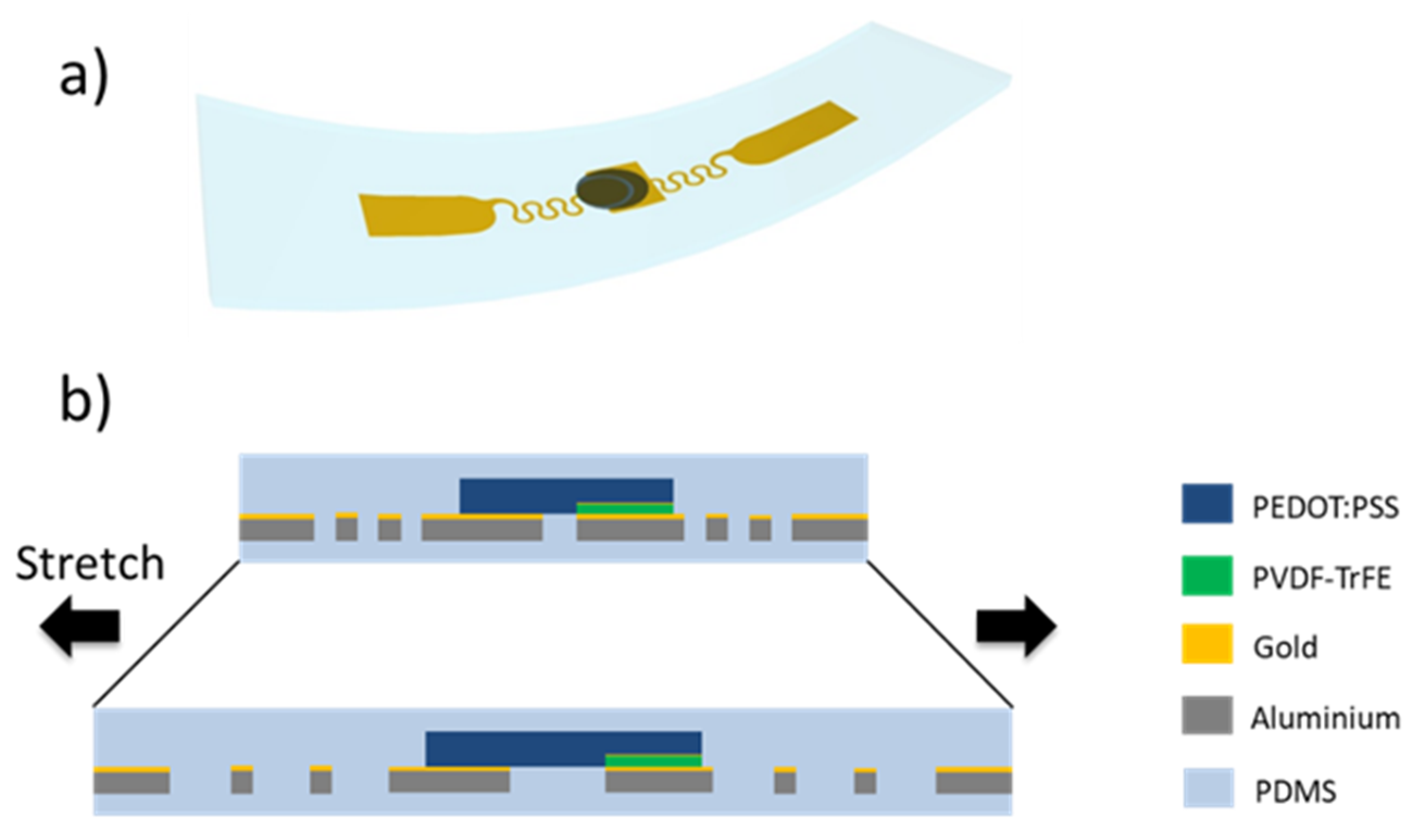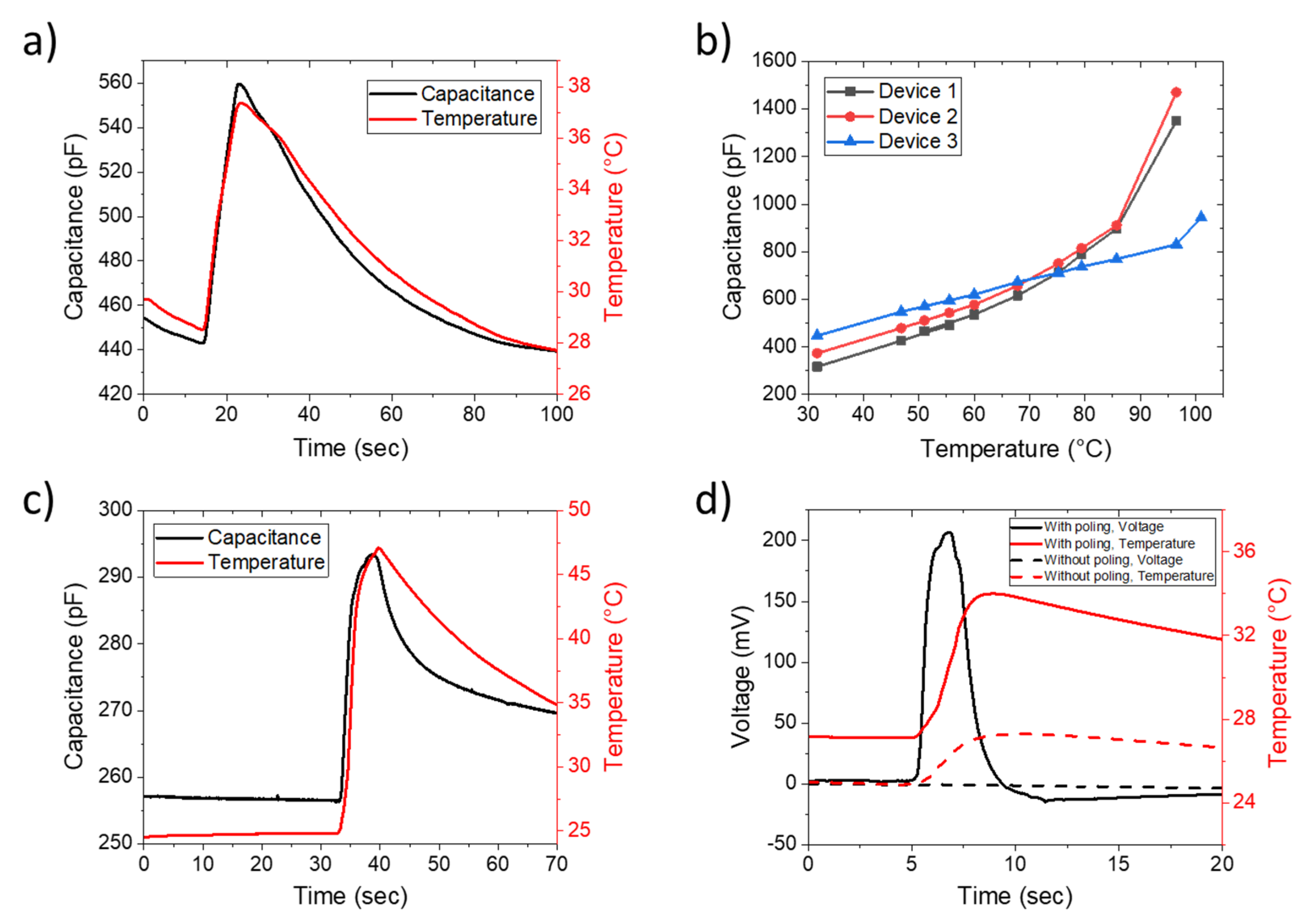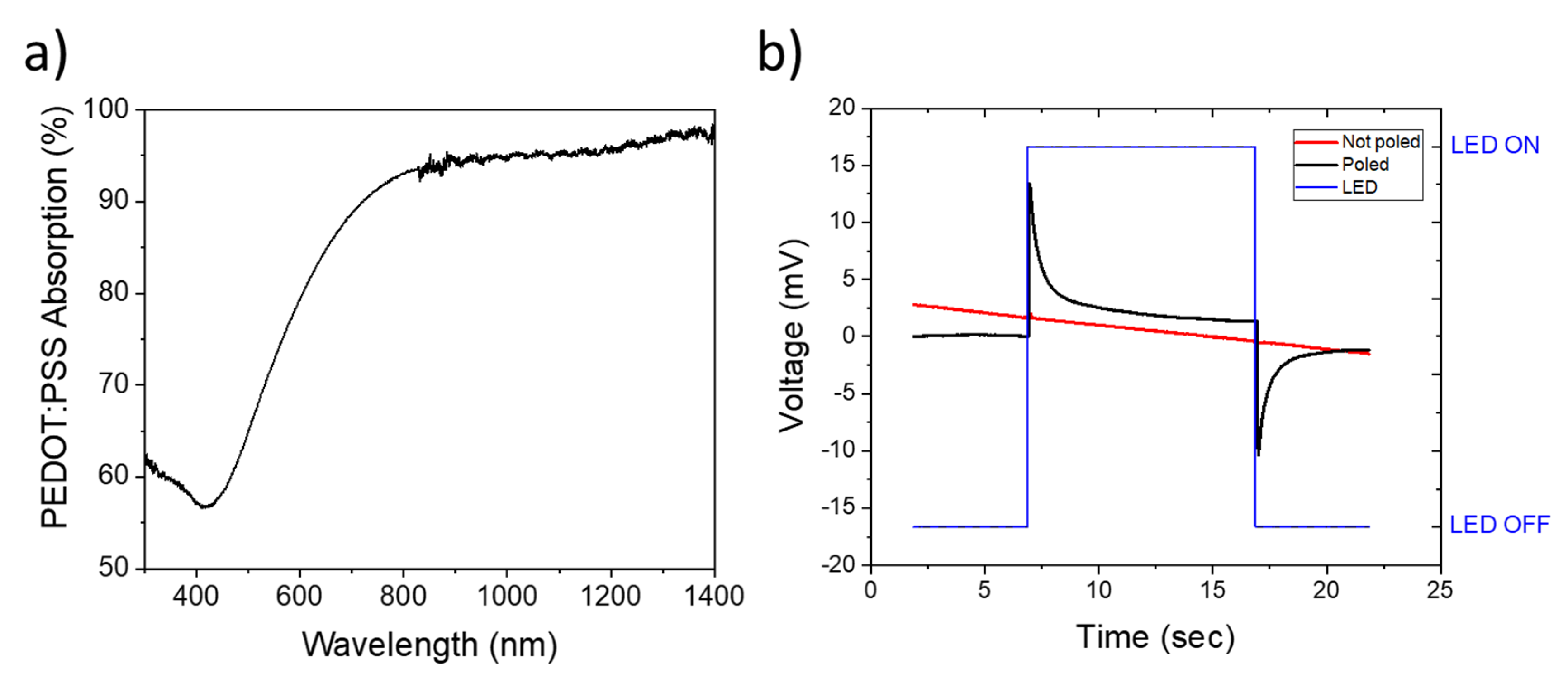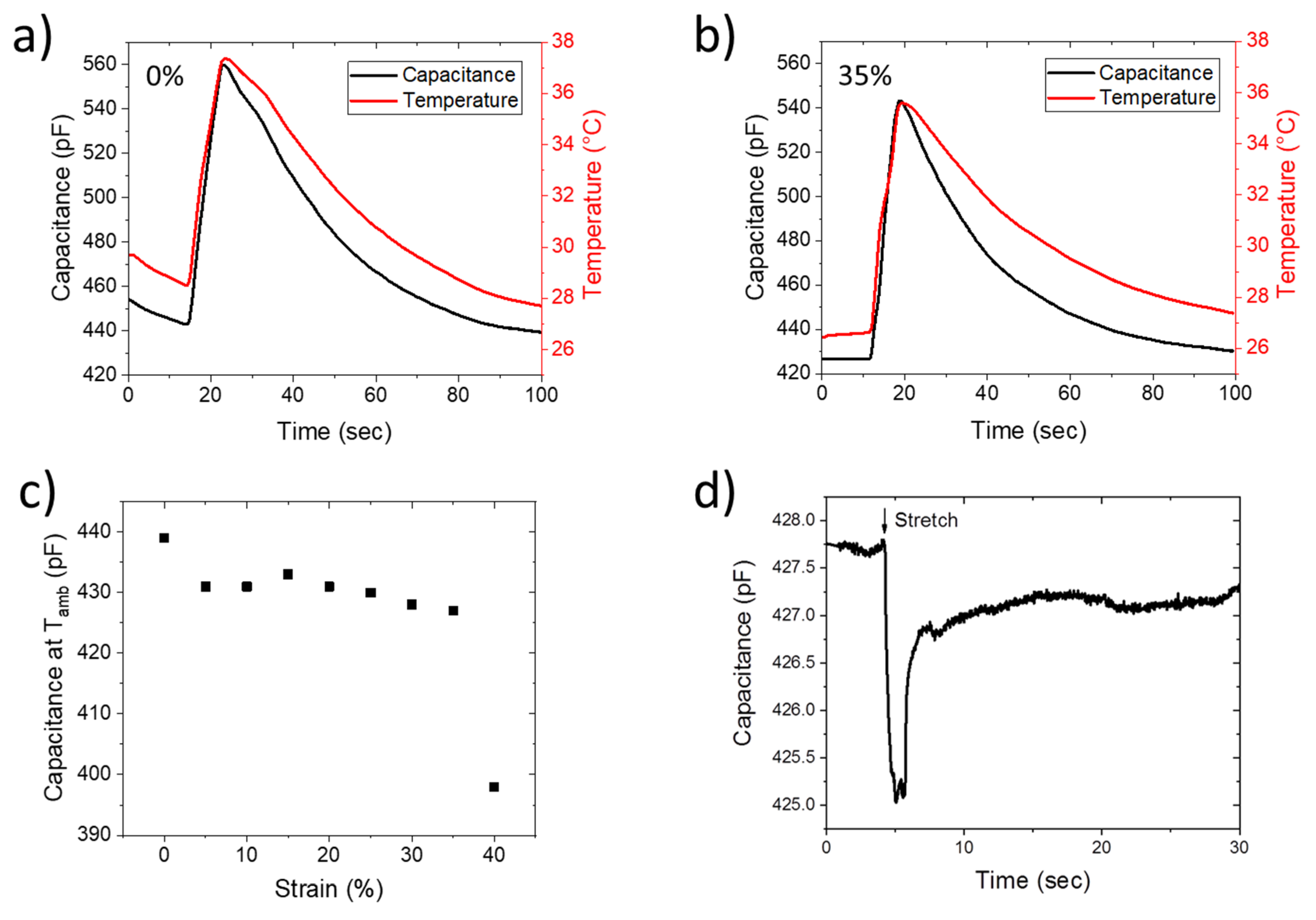PVDF-TrFE-Based Stretchable Contact and Non-Contact Temperature Sensor for E-Skin Application
Abstract
:1. Introduction
2. Materials and Methods
3. Results and Discussion
3.1. Design of the Sensor
3.2. Characterization of the Device under Temperature Change
3.3. Characterization of the Device under Illumination
3.4. Characterization of the Device under Stretch
4. Conclusions
Supplementary Materials
Author Contributions
Funding
Acknowledgments
Conflicts of Interest
References
- Someya, T.; Sekitani, T.; Iba, S.; Kato, Y.; Kawaguchi, H.; Sakurai, T. A large-area, flexible pressure sensor matrix with organic field-effect transistors for artificial skin applications. Proc. Natl. Acad. Sci. USA 2004, 101, 9966–9970. [Google Scholar] [CrossRef] [Green Version]
- Kim, D.-H.; Viventi, J.; Amsden, J.J.; Xiao, J.; Vigeland, L.; Kim, Y.-S.; Blanco, J.A.; Panilaitis, B.; Frechette, E.S.; Contreras, D.; et al. Dissolvable films of silk fibroin for ultrathin conformal bio-integrated electronics. Nat. Mater. 2010, 9, 511–517. [Google Scholar] [CrossRef]
- Rogers, J.A.; Someya, T.; Huang, Y. Materials and Mechanics for Stretchable Electronics. Science 2010, 327, 1603–1607. [Google Scholar] [CrossRef] [Green Version]
- Liu, Y.; Pharr, M.; Salvatore, G.A. Lab-on-Skin: A Review of Flexible and Stretchable Electronics for Wearable Health Monitoring. ACS Nano 2017, 11, 9614–9635. [Google Scholar] [CrossRef]
- Yousef, H.; Boukallel, M.; Althoefer, K. Tactile sensing for dexterous in-hand manipulation in robotics—A review. Sens. Actuators Phys. 2011, 167, 171–187. [Google Scholar] [CrossRef]
- Lipomi, D.J.; Lee, J.A.; Vosgueritchian, M.; Tee, B.C.-K.; Bolander, J.A.; Bao, Z. Electronic Properties of Transparent Conductive Films of PEDOT: PSS on Stretchable Substrates. Chem. Mater. 2012, 24, 373–382. [Google Scholar] [CrossRef]
- Xu, F.; Zhu, Y. Highly Conductive and Stretchable Silver Nanowire Conductors. Adv. Mater. 2012, 24, 5117–5122. [Google Scholar] [CrossRef]
- Matsuhisa, N.; Kaltenbrunner, M.; Yokota, T.; Jinno, H.; Kuribara, K.; Sekitani, T.; Someya, T. Printable elastic conductors with a high conductivity for electronic textile applications. Nat. Commun. 2015, 6. [Google Scholar] [CrossRef]
- Sekitani, T.; Someya, T. Stretchable, Large-area Organic Electronics. Adv. Mater. 2010, 22, 2228–2246. [Google Scholar] [CrossRef]
- Song, J.; Feng, X.; Huang, Y. Mechanics and thermal management of stretchable inorganic electronics. Natl. Sci. Rev. 2016, 3, 128–143. [Google Scholar] [CrossRef]
- Zhang, Y.; Huang, Y.; Rogers, J.A. Mechanics of stretchable batteries and supercapacitors. Curr. Opin. Solid State Mater. Sci. 2015, 19, 190–199. [Google Scholar] [CrossRef]
- Kim, D.-H.; Lu, N.; Ma, R.; Kim, Y.-S.; Kim, R.-H.; Wang, S.; Wu, J.; Won, S.M.; Tao, H.; Islam, A.; et al. Epidermal Electronics. Science 2011, 333, 838–843. [Google Scholar] [CrossRef] [Green Version]
- Yokota, T.; Inoue, Y.; Terakawa, Y.; Reeder, J.; Kaltenbrunner, M.; Ware, T.; Yang, K.; Mabuchi, K.; Murakawa, T.; Sekino, M.; et al. Ultraflexible, large-area, physiological temperature sensors for multipoint measurements. Proc. Natl. Acad. Sci. 2015, 112, 14533–14538. [Google Scholar] [CrossRef] [Green Version]
- Kim, J.; Lee, M.; Shim, H.J.; Ghaffari, R.; Cho, H.R.; Son, D.; Jung, Y.H.; Soh, M.; Choi, C.; Jung, S.; et al. Stretchable silicon nanoribbon electronics for skin prosthesis. Nat. Commun. 2014, 5, 5747. [Google Scholar] [CrossRef] [Green Version]
- Osborn, L.E.; Dragomir, A.; Betthauser, J.L.; Hunt, C.L.; Nguyen, H.H.; Kaliki, R.R.; Thakor, N.V. Prosthesis with neuromorphic multilayered e-dermis perceives touch and pain. Sci. Robot. 2018, 3, eaat3818. [Google Scholar] [CrossRef] [Green Version]
- Webb, R.C.; Bonifas, A.P.; Behnaz, A.; Zhang, Y.; Yu, K.J.; Cheng, H.; Shi, M.; Bian, Z.; Liu, Z.; Kim, Y.-S.; et al. Ultrathin conformal devices for precise and continuous thermal characterization of human skin. Nat. Mater. 2013, 12, 938–944. [Google Scholar] [CrossRef]
- Ploss, B.; Ploss, B.; Shin, F.G.; Chan, H.L.W.; Choy, C.L. Pyroelectric Activity of Ferroelectric PT/PVDF-TRFE. IEEE Trans. Dielectr. Electr. Insul. 2000, 7, 517–522. [Google Scholar] [CrossRef]
- Kawai, H. The piezoelectricity of poly (vinylidene fluoride). J. Appl. Phys. 1969, 8, 975–976. [Google Scholar] [CrossRef]
- Bergman, J.G.; McFee, J.H.; Crane, G.R. Pyroelectricity and optical second harmonic generation in polyvinylidene fluoride films. Appl. Phys. Lett. 1971, 18, 203–205. [Google Scholar] [CrossRef]
- Kepler, R.G. Piezoelectricity, pyroelectricity, and ferroelectricity in organic materials. Annu. Rev. Phys. Chem. 1978, 29, 497–518. [Google Scholar] [CrossRef]
- Takahashi, Y.; Matsubara, Y.; Tadokoro, H. Mechanisms for crystal phase transformations by heat treatment and molecular motion in poly (vinylidene fluoride). Macromolecules 1982, 15, 334–338. [Google Scholar] [CrossRef]
- Li, W.; Zhu, Y.; Hua, D.; Wang, P.; Chen, X.; Shen, J. Crystalline morphologies of P(VDF-TrFE) (70/30) copolymer films above melting point. Appl. Surf. Sci. 2008, 254, 7321–7325. [Google Scholar] [CrossRef]
- Koga, K.; Ohigashi, H. Piezoelectricity and related properties of vinylidene fluoride and trifluoroethylene copolymers. J. Appl. Phys. 1986, 59, 2142–2150. [Google Scholar] [CrossRef]
- Bihler, E.; Neumann, G.; Eberle, G.; Eisenmenger, W. Influence of charge injection on the formation of remanent polarization in P (VDF-TrFE) copolymers. In Proceedings of the Annual Conference on Electrical Insulation and Dielectric Phenomena, Pocono Manor, PA, USA, 28–31 October 1990; pp. 140–145. [Google Scholar]
- Freitag, R.; Meixner, H. PVDF sensor array for human body detection. In Proceedings of the Annual Conference on Electrical Insulation and Dielectric Phenomena, Oxford, UK, 1–3 September 1988; pp. 374–378. [Google Scholar]
- Advena, D.J.; Bly, V.T.; Cox, J.T. Deposition and characterization of far-infrared absorbing gold black films. Appl. Opt. 1993, 32, 1136–1144. [Google Scholar] [CrossRef]
- Lehman, J.; Theocharous, E.; Eppeldauer, G.; Pannell, C. Gold-black coatings for freestanding pyroelectric detectors. Meas. Sci. Technol. 2003, 14, 916–922. [Google Scholar] [CrossRef] [Green Version]
- Levesque, M.; Cote, M.; Lelievre, S.; Galarneau, P. P (VDF-TrFE) infrared detectors and array. In Proceedings of the SPIE’s 1994 International Symposium on Optics, Imaging, and Instrumentation, San Diego, CA, USA, 17 October 1994; pp. 124–131. [Google Scholar]
- Fujitsuka, N.; Sakata, J.; Miyachi, Y.; Mizuno, K.; Ohtsuka, K.; Taga, Y.; Tabata, O. Monolithic pyroelectric infrared image sensor using PVDF thin film. Sens. Actuators Phys. 1998, 66, 237–243. [Google Scholar] [CrossRef]
- Pecora, A.; Maiolo, L.; Maita, F.; Minotti, A. Flexible PVDF-TrFE pyroelectric sensor driven by polysilicon thin film transistor fabricated on ultra-thin polyimide substrate. Sens. Actuators Phys. 2012, 185, 39–43. [Google Scholar] [CrossRef]
- Marchiori, B.; Delattre, R.; Hannah, S.; Blayac, S.; Ramuz, M. Laser-patterned metallic interconnections for all stretchable organic electrochemical transistors. Sci. Rep. 2018, 8, 8477. [Google Scholar] [CrossRef] [Green Version]
- Vosgueritchian, M.; Lipomi, D.J.; Bao, Z. Highly Conductive and Transparent PEDOT: PSS Films with a Fluorosurfactant for Stretchable and Flexible Transparent Electrodes. Adv. Funct. Mater. 2012, 22, 421–428. [Google Scholar] [CrossRef]
- Lipomi, D.J.; Tee, B.C.-K.; Vosgueritchian, M.; Bao, Z. Stretchable Organic Solar Cells. Adv. Mater. 2011, 23, 1771–1775. [Google Scholar] [CrossRef]
- Hannah, S.; Davidson, A.; Glesk, I.; Uttamchandani, D.; Dahiya, R.; Gleskova, H. Multifunctional sensor based on organic field-effect transistor and ferroelectric poly(vinylidene fluoride trifluoroethylene). Org. Electron. 2018, 56, 170–177. [Google Scholar] [CrossRef]
- Cai, M.; Nie, S.; Du, Y.; Wang, C.; Song, J. Soft Elastomers with Programmable Stiffness as Strain-Isolating Substrates for Stretchable Electronics. ACS Appl. Mater. Interfaces 2019, 11, 14340–14346. [Google Scholar] [CrossRef]




© 2020 by the authors. Licensee MDPI, Basel, Switzerland. This article is an open access article distributed under the terms and conditions of the Creative Commons Attribution (CC BY) license (http://creativecommons.org/licenses/by/4.0/).
Share and Cite
Marchiori, B.; Regal, S.; Arango, Y.; Delattre, R.; Blayac, S.; Ramuz, M. PVDF-TrFE-Based Stretchable Contact and Non-Contact Temperature Sensor for E-Skin Application. Sensors 2020, 20, 623. https://doi.org/10.3390/s20030623
Marchiori B, Regal S, Arango Y, Delattre R, Blayac S, Ramuz M. PVDF-TrFE-Based Stretchable Contact and Non-Contact Temperature Sensor for E-Skin Application. Sensors. 2020; 20(3):623. https://doi.org/10.3390/s20030623
Chicago/Turabian StyleMarchiori, Bastien, Simon Regal, Yanid Arango, Roger Delattre, Sylvain Blayac, and Marc Ramuz. 2020. "PVDF-TrFE-Based Stretchable Contact and Non-Contact Temperature Sensor for E-Skin Application" Sensors 20, no. 3: 623. https://doi.org/10.3390/s20030623
APA StyleMarchiori, B., Regal, S., Arango, Y., Delattre, R., Blayac, S., & Ramuz, M. (2020). PVDF-TrFE-Based Stretchable Contact and Non-Contact Temperature Sensor for E-Skin Application. Sensors, 20(3), 623. https://doi.org/10.3390/s20030623



